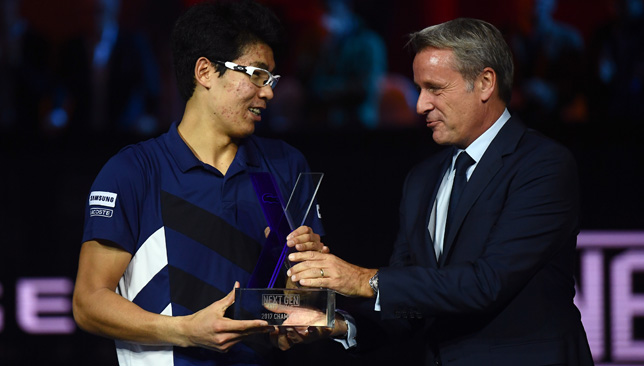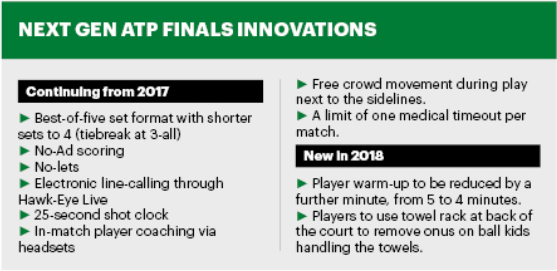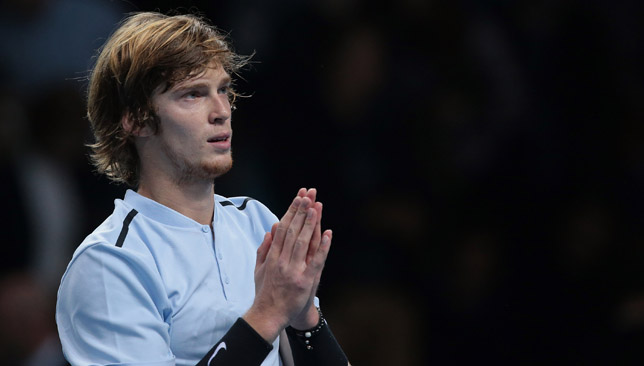
Some of the changes and innovations that are being tested at the Next Gen ATP Finals can be introduced to the main tour as early as next season, ATP president Chris Kermode told reporters in Rome.
The second edition of the 21-and-under end-of-season tournament will take place in Milan from November 6-10, 2018, and Kermode made some interesting revelations at the event’s launch on Tuesday.
Besides creating a chance to promote the younger generation of tennis players, the ATP is using the Next Gen Finals as a way to test several rule changes and innovations. The matches are played over best-of-five sets but with each set going up to four, with a tiebreak played at 3-all.
Shot clocks count down from 25 seconds on court to make sure players don’t exceed the allotted time between points, Hawk-Eye Live is used to make the line calls instead of line judges and headsets are used to on-court coaching sessions between players and their coaches.


Andrey Rublev says some of Next Gen ATP Finals new rules make the game unfair
Those are just some of the many ideas tested at the Milan showpiece and it seems we can expect some of those changes to be applied on the ATP tour next season.
“There are some ones that I think we could fast-track, 2019 or 2020 we can get in shot clocks and reduced warm-ups, I think that will happen and I think that’s a good thing,” Kermode told reporters in Rome.
“You need buy-in from players obviously, you need buy-in from tournament promoters, from fans, from media and from sponsors.
“I think allowing promoters to have the freedom to be flexible on the free movement of people, because it’s a cultural thing. Certain countries are completely fine with everyone jumping up and down and moving around and free movement, other countries are less tolerant of that. So we don’t want to do a one size fits all for that but give the promoter the freedom to allow it if it works for their country.
“I think we’ll look at reducing things like use of medical timeouts and toilet breaks and those sort of things, I think those will happen the quickest.
“The scoring will always take the longest, because things like deuce, advantage, no-lets, they do potentially change the outcome of the match and that’s why you’ve got to be more careful rather than rushing in.”
Current top 8 in Next Gen Race to Milan: pic.twitter.com/G8LtpLoeR4
— Reem Abulleil (@ReemAbulleil) May 15, 2018
One new aspect to this year’s Next Gen Finals is the introduction of a towel rack placed at the back of the court, to remove the onus on ball kids to handle towels.
“We wanted to keep looking at little bits and pieces, some are dramatic like the scoring system, some are smaller like this. But let’s see, does this speed play up?” Kermode told Sport360 after the announcement.
“It could actually make it longer because they have to go back. Obviously they still have to play within 25 seconds but maybe they go up to the 25 seconds max each time, but maybe they actually skip using it as much and it speeds the whole play up. Let’s see. I think there’s also a perception issue as well, which I personally don’t like and I think it’s something we should try.”
The ATP is looking to use data from several editions of the tournament before making any drastic changes to the actual format of tennis matches.
The surveys they conducted at last year’s event in Milan have revealed that 90.6 per cent of participants (people on-site) found that the tournament “went beyond their expectations”.
Also according to the ATP, 85.8 per cent of participants believe it’s a good idea for the tour to try new things.
However research showed that the average match times at the Next Gen Finals were not so different from those of ATP tournaments.
Kermode still thinks the Fast-4 format is more enjoyable, even if it’s not shaving time off of matches.
“The advantage for me is the intensity of play right from the start,” said Kermode.
“So there were no down moments and that’s the thing I think we’ve got to look for the – this is about the next generation of fans, so people, old like me, 50+, we’re not the people to ask.
“Because if you’re going to do a survey with those people in my demographic, they’re all going to say keep it exactly how it is, that’s why we watch the sport, we love it how it is. And I get that, but I’m looking 10 years ahead.
“My kids are in their 20s, how they are consuming all types of media, entertainment and sports and everything, is changing so quickly and therefore what is going to be required for any sport or entertainment survive, it’s got to be dynamic. It’s like cricket, the idea of watching a county cricket match now, you can see there’s three people in the stands. Twenty20, the Big Bash, awesome, it’s packed.
“And it’s how you get the balance of keeping the things that work in the sport but not completely mess with the game. I think this will be a long way off happening on the main tour but I’m very pleased that we’ve given it a go because I was bowled over by how intense it was.”
8 Next Gen players the ATP are promoting pic.twitter.com/NoOpkh9W9q
— Reem Abulleil (@ReemAbulleil) May 15, 2018
Electronic line-calling has caused a stir with the worry over the future jobs of current line judges.
Kermode believes there will always be a need for line umpires because Hawk-Eye Live is an expensive technology that won’t be available on every court at every tournament.
“First of all, you’ll always need line judges. It’ll be like Hawk-Eye at the big venues, it’s only on certain courts. So you’re going to need line judges at the big Masters series events, at the Grand Slams, 500s, 250s, Challengers, Futures, you’re going to need them because obviously the technology for what we did in Milan is expensive. So I don’t see people suddenly going ‘there’s no line judges’. It won’t be that extreme,” he explained.
The current leader of the Race to Milan standings is 21-year-old Alexander Zverev, who also led the rankings last year but opted out of playing the Next Gen Finals because he qualified for the tour’s ATP Finals.
Zverev, currently ranked No. 3 in the world, is in the same position this season as well.
Greece’s Stefanos Tsitspas, an alternate last year in Milan, is No. 2 in the Next Gen race and No. 23 in the Race to London.
Kermode said any player who qualifies for both the Next Gen Finals and ATP Finals will not be obliged to compete in the 21-and-under tournament.
Denis Shapovalov, No. 3 in the Race to Milan and currently ranked 29 in the world rankings, competed in last year’s event and is keen on going there again this year.
“We’ll see how the season unravels. But, yeah, it’s a nice tournament to play at the end of the year. There’s no pressure. It’s just a bonus event. So, it was a lot of fun last year,” said the 19-year-old Canadian.
“Yeah, I definitely want to go play.”